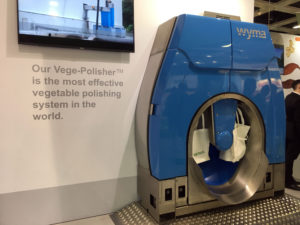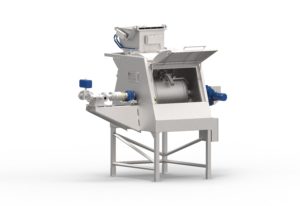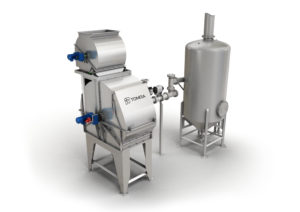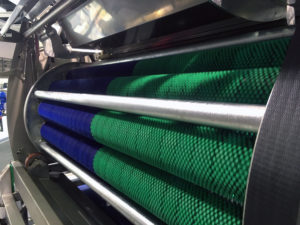Produce peeling choice comes down to what fits your need
Choosing the right polishing peeling technology for the job is no easy task.
Different types of peelers will give different finishes, and their maintenance will vary, depending on which style you choose — brush, grit or knife. Ultimately, the choice will depend on the end product.
Four companies shared their expertise and showcased their peeling equipment at Fruit Logistica 2019 in Berlin.
Breaking down peeling technology

Choosing the right polisher or peeler starts with understanding needs. Specifically, what food producers need to be aware of when they’re choosing a machine is the type of technology available and which is the best fit for their needs, said Stuart Allen-Oldham, territory manager at Wyma.
“The brush technology that we use allows us to get into the dents — we can get into that and peel that so you don’t have a lot of yield loss,” he said, referring to their Vege-Peeler. “If you take a knife peeler, it would have to cut all around it, so you’d have much higher yield loss. But you get a much smoother finish with the knife.
“A knife peeler gives you a very smooth finish, which with a french fry helps with frying. With a brush peeler, it doesn’t give that smooth finish, but it gives a much better yield.”
Grit or carborundum, on the other hand, is not quite as aggressive as a knife, but it results in a higher yield loss than a brush. And the grit is expensive to change, but the knives blunt as well. Allen-Oldham said that if a brush is suitable, its benefits are that it doesn’t require much maintenance and it will last a couple of years. “Clean in place” (CIP) technology will keep hygiene at its optimum level.
“It’s very important that the supplier understands the end goal and the customer understands the options of what they are trying to achieve,” Allen-Oldham said.
Brush peelers are most suitable for hash browns and other processed potato products that don’t lose their appeal when that smooth texture is compromised. They also work well in conjunction with a steam peeler.
“A steam peeler can take quite a lot of maintenance,” he said. “If you get dirt on a steam peeler, then it’s a very costly thing when you have a breakdown to clean. Whereas, if you put one of our peelers in front of it, it takes away all that dirt and loose skin, and then the steam peeler does that nice, finishing peel.
“That has a really good return on investment.”
Wyma’s Vege-Peeler peels a variety of vegetables, including carrots, potatoes, sweet potatoes, swede (or rutabagas) and beets. It is available with custom designed brushes or a combination of brushes and carborundum. The peeler has achieved yield losses as low as 5 percent on certain vegetables. Wyma also sells a Vege-polisher for those who are looking for a more finished look to fresh produce.
Steam peeling vs. cold peeling

In terms of peeling technology, steam peeling is pretty new to the scene. Before that, everything was done cold with brushes, knives and grit, said Gerard van Pernis, salesperson for Eima.
“How to peel depends on what the end product is,” Van Pernis said.
A smooth finish potato will be peeled cold with knives, he said. “People who buy them from the supermarket want to see that they’re peeled almost like by hand,” he said. “But when you do it for mashed potatoes, it doesn’t matter at all how it looks.”
Steam, he said, produces less waste and can be done much quicker than the other options. Recently, he’s had clients switch from knives to steam to save on water usage. Steam also uses less energy, he said.
“These are important issues nowadays,” Van Pernis said.
Eima offers peeling solutions for all types of end products.
Gaining steam

With the launch of its Eco peeler, Belgian company TOMRA has found major savings in steam. TOMRA’s biggest market is in potatoes where the Eco steam peeler is a perfect fit for fries and specialty products, like hash browns, said Karel Strubbe, sales director, EMEA region, TOMRA.
“This is a segment where yields are critical,” he said. “The customers who use our equipment are using it day in and day out, 24/7, and every percentage that they can gain or not lose is a benefit to them.”
The Eco steam peeler, Strubbe said, produces the least amount of waste and lowers energy usage by up to 25 percent. “It’s the most economical to run because the consumption of steam is very limited,” he said.
In fact, Strubbe believes that steam is the only efficient way of peeling in the french fry and specialty potato sector. More and more, Strubbe said clients who would typically use knives or brushes to remove peels are making the switch to steam.
For processors dealing with very seasonal vegetables that need peeling, but don’t justify the cost of a large-scale steam peeler, TOMRA has developed a budget-friendly option called Odyssey. Strubbe said the idea behind its development was to offer a cost-effective steam peeling solution for seasonal processors and emerging markets. Odyssey is designed to be a good choice for potatoes, red beets, pumpkins, celeriac, kohlrabi, papaya, mango and chilies.
Alternative to peeling

While it’s mostly big processors who purchase brush cleaners to remove soil from potatoes and carrots, John Rietveld, owner of Rietveld Equipment in the U.S., said he’s sold Allround brush peelers to all kinds of customers. There’s a different machine — that operates at a different scale — that suits the needs of his customers.
One customer, for instance, is a small-scale producer from Illinois who sells his potatoes at the local farmers’ markets. “He really wants to have a fancy appearance,” Rietveld said.
Rather than peeling or scrubbing, this particular customer chose a washing and polishing line to clean up his fingerling and regular potatoes, parsnips, carrots and red beets. He sells to local, high-end restaurants where aesthetics are important and demand for locally grown produce is high. Being able to meet those demands means fetching a good price.
Allround also deals with larger-scale growers who sell to processors or sell their own fresh-packed vegetables.
— Melanie Epp is a freelance agricultural journalist. Learn more at melanierepp.com.







